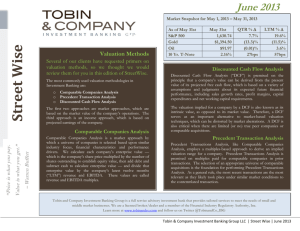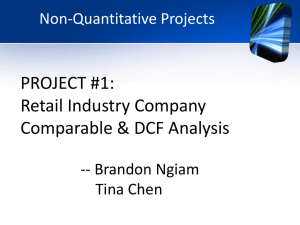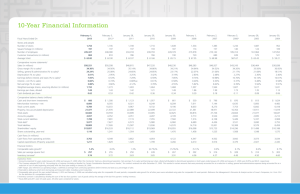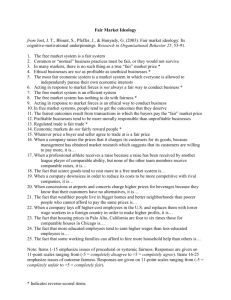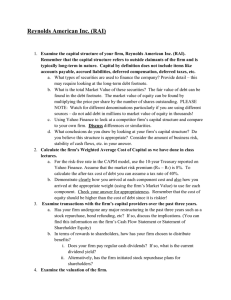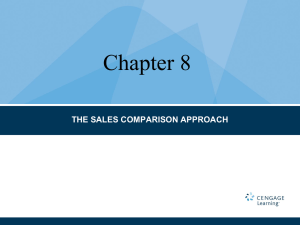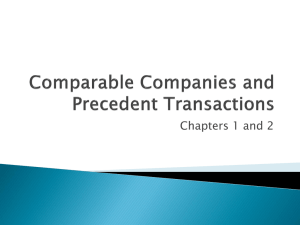Primer on Relative Valuation Methodology
advertisement
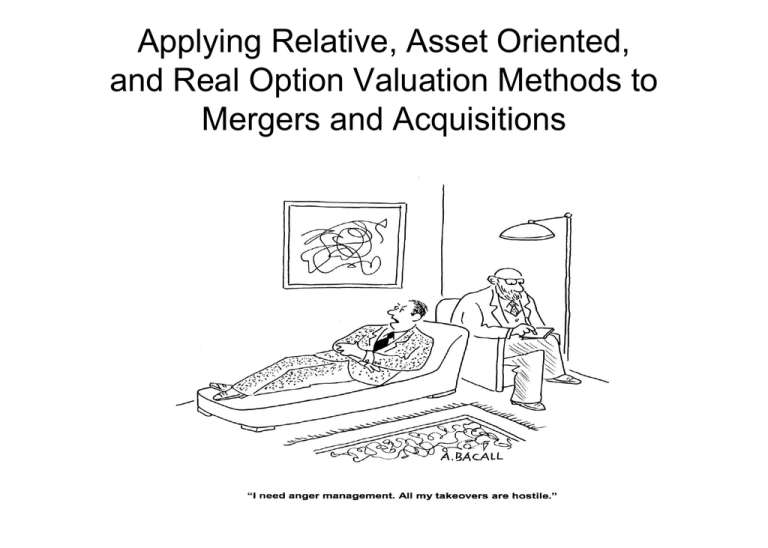
Applying Relative, Asset Oriented, and Real Option Valuation Methods to Mergers and Acquisitions You earn a living by what you get, but you build a life by what you give. —Winston Churchill Exhibit 1: Course Layout: Mergers, Acquisitions, and Other Restructuring Activities Part I: M&A Environment Part II: M&A Process Part III: M&A Valuation and Modeling Part IV: Deal Structuring and Financing Part V: Alternative Business and Restructuring Strategies Ch. 1: Motivations for M&A Ch. 4: Business and Acquisition Plans Ch. 7: Discounted Cash Flow Valuation Ch. 11: Payment and Legal Considerations Ch. 15: Business Alliances Ch. 2: Regulatory Considerations Ch. 5: Search through Closing Activities Ch. 8: Relative Valuation Methodologies Ch. 12: Accounting & Tax Considerations Ch. 16: Divestitures, Spin-Offs, Split-Offs, and Equity Carve-Outs Ch. 3: Takeover Tactics, Defenses, and Corporate Governance Ch. 6: M&A Postclosing Integration Ch. 9: Financial Modeling Techniques Ch. 13: Financing the Deal Ch. 17: Bankruptcy and Liquidation Ch. 10: Private Company Valuation Ch. 14: Valuing Highly Leveraged Transactions Ch. 18: Cross-Border Transactions Learning Objectives • Primary learning objective: To provide students with knowledge of alternatives to discounted cash flow valuation methods, including – Market Approach • Comparable companies • Comparable transactions • Same industry or comparable industry – Asset oriented approach • Tangible book value • Liquidation value • Break-up value – Replacement Cost approach – Weighted average method • Secondary learning objective: Enable students to understand how real options apply to M&As Applying Market-Based (Relative Valuation) Methods1 MVT = (MVC / VIC) x VIT Where MVT MVC VIC VIT (MVC/VIC) 1Comparable = Market value of target company = Market value of the comparable company C2 = Measure of value for comparable company C = Measure of value for company T = Market value multiple for the comparable company companies may include those with profitability, risk, and growth characteristics similar to the target firm; they are not necessarily found in the same industry as the target firm. Risk may be measured by the beta and the D/E or D/TC ratios. 2To identify comparable firms, calculate correlation coefficients with respect to revenue, profit, or cash flows of firms in the same or similar industries. Relationship Between DCF and Market Multiples Perpetuity DCF Model and P (price per share)/E (earnings per share) ratios: P = E / ke (perpetuity model), dividing both sides by E gives P / E = $1 / ke, which is the amount investors are willing to pay for $1 of earnings in perpetuity ex. If E = $1, the earnings payout ratio is 100%, and ke is 10%, then P / E = $1 / .10 = $10 per dollar of earnings Constant Growth DCF Model and P/E ratios: PV = E (1 + g) / (ke – g) (constant growth model), dividing both sides by E P / E = $1(1 + g) / (ke – g), the amount investors are willing to pay for $1 of earnings growing at a constant growth rate g. ex. If E = $1, the earnings payout ratio is 100%, ke is 10%, and the earnings growth rate is 5%, then P / E = $1 x 1.00 x (1.05) / (.10 - .05) = $21 per dollar of earnings. Key Point: When comparing firms with different P/E ratios, which is more attractive depends on the expected earnings growth rate, payout ratio, and rate at which earnings can be reinvested. Market-Based Methods: Comparable Company Example Exhibit 8-1. Valuing Repsol YPF Using Comparable Integrated Oil Companies Target Valuation Based on Following Multiples (MVC/VIC): Comparable Company Exxon Mobil Corp (XOM) Trailing P/E1 Forward P/E2 Price/Sales Price/Book Col. 1 Col. 2 Col. 3 Col. 4 11.25 8.73 1.17 3.71 9.18 7.68 0.69 2.17 10.79 8.05 0.91 2.54 7.36 8.35 0.61 1.86 11.92 6.89 0.77 1.59 Total SA (TOT) 8.75 8.73 0.80 2.53 Eni SpA (E) 3.17 7.91 0.36 0.81 11.96 10.75 1.75 2.10 9.30 8.39 0.88 2.16 $4.38 $3.27 $92.66 $26.49 $40.73 $27.44 $81.54 $57.22 British Petroleum (BP) Chevron Corp (CVX) Royal Dutch Shell (RDS-B) ConocoPhillips (COP) PetroChina Co. (PTR) Average Multiple (MVC/VIC) Times Repsol YPF Projections (VIT)3 Equals Estimated Mkt. Value of Target3 1Trailing 52 week average. 2Projected 52 week average. 3Billions of Dollars. Key Points: 1. Firm valuation differs significantly depending on valuation multiple used. 2. Valuation estimates require addition of a purchase price premium. Average Col. 1-4 $51.73 Market-Based Methods: Recent Transactions’ Method1 • Calculation similar to comparable companies’ method, except multiples used to estimate target’s value based on purchase prices of recent transactions of comparable companies. MVT = (MVRT / VIRT) x VIT Where MVT = Market value of target company T MVRT = Market value of the recently acquired comparable company RT VIRT = Measure of value for recently acquired comparable company RT VIT = Measure of value for target company T (MVRT/VIRT) = Market value multiple for the recently acquired comparable company RT • • • Most accurate method whenever the transaction is truly comparable and very recent. Major limitation is that truly comparable recent transactions are rare. Valuations based on this method already include a purchase price premium 1Also called precedent method. Market-Based Methods: Same or Comparable Industry Method • Multiply target’s earnings or revenues by market value to earnings or revenue ratios for the average firm in target’s industry or a comparable industry. MVT = (MVAF / VIAF) x VIT Where MVT MVAF VIAF VIT (MVAF/VIAF) • • • = Market value of target firm = Market value of average firm (AF) in target firm’s or comparable industry = Measure of value for average firm in target firm’s or comparable Industry = Measure of value for target company T = Market value multiple for the average firm in target firm’s or comparable industry Primary advantage is the ease of use and availability of data. Disadvantages include presumption industry multiples are actually comparable and analysts’ projections are unbiased. Requires addition of purchase price premium PEG Ratio • • • Firm A and Firm B have P/Es of 20 and 15, respectively. Which is more attractive? PEG Ratio used to adjust relative valuation methods for differences in growth rates among comparable firms. Helpful in determining which of a number of different firms in same industry exhibiting different growth rates may be the most attractive. (MVT/VIT) = A and VITGR MVT = A x VITGR x VIT Where A MVT VIT VITGR • = Market price to value indicator relative to the growth rate of value indicator (e.g., (P/E)/ EPS growth rate) = Market value of target = Value indicator for target (e.g., EPS) = Projected growth rate in value indicator (e.g., EPS)1 Firms whose PEG ratios > 1 considered overvalued; PEG ratios < 1 considered undervalued 1Valid for VITGR > 0. For VITGR = 0 or < 0, firm value will not change or will decline. Applying the PEG Ratio An analyst is asked to determine whether Basic Energy Service (BES) or Composite Production Services (CPS) is more attractive as an acquisition target. Both firms provide engineering, construction, and specialty services to the oil, gas, refinery, and petrochemical industries. BES and CPS have projected annual earnings per share growth rates of 15 percent and 9 percent, respectively. BES’ and CPS’ current earnings per share are $2.05 and $3.15, respectively. The current share prices as of June 25, 2008 for BES is $31.48 and for CPX is $26. The industry average price-to-earnings ratio and growth rate are 12.4 and 11 percent, respectively. Based on this information, which firm is a more attractive takeover target (i.e., more undervalued) as of the point in time the firms are being compared? Industry average PEG ratio:1 (MVT/VIT) / VITGR = A = 12.4/11 = 1.1273 BES: Implied share price = A x VITGR x VIT = 1.1273 x 15 x $2.05 = $34.66 CPX: Implied share price = A x VITGR x VIT = 1.1273 x 9 x $3.15 = $31.96 Answer: The difference between the implied and actual share prices for BES and CPX is $3.18 (i.e., $34.66 - $31.48) and $5.96 ($31.96 - $26.00), respectively. CPX is more undervalued than BES at that moment in time and therefore is the more attractive takeover target. MVT = A x VITGR x VIT using an individual firm’s PEG ratio provides the firm’s current share price in period T, since this formula is an identity. An industry average PEG ratio may be used to provide an estimate of the firm’s intrinsic value. This implicitly assumes that the target firm and the average firm in the industry exhibit the same relationship between price-to-earnings ratios and earnings growth rates. 1Solving Asset-Based Methods: Tangible Book Value • Tangible book value (TBV) = (total assets - total liabilities - goodwill) MVT = (MVC / VICTBV) x VITTBV Where MVT = Market value of target company T MVC = Market value of the comparable company C VICTBV = Tangible book value for comparable company C VITTBV = Tangible book value for target company T (MVC/ICTBV) = Market value multiple for the comparable company • Often used for valuing – Financial services firms where tangible book value is primarily cash or liquid assets – Distribution firms where current assets constitute a large percentage of total assets Valuing Companies Using Asset Based Methods: Practice Problem Ingram Micro distributes information technology products worldwide. The firm’s share price on 8/21/08 was $19.30. Projected 5-year annual net income growth is 9.5% and the firm’s beta is .89. Shareholders’ equity is $3.4 billion and goodwill is $.7 billion. Ingram has 172 million (.172 billion) shares outstanding. The following firms represent Ingram’s primary competitors. Note that Synnex Corporation can be viewed as an outlier. Market Value/ Tangible Book Value Beta Projected 5-Year Net Income Growth Rate (%) Tech Data .91 .90 11.6 Synnex Corporation .70 .40 6.9 Avnet 1.01 1.09 12.1 Arrow .93 .97 13.2 Based on this information, what is Ingram’s tangible book value per share (VIT)? What is the appropriate industry average market value to tangible book value ratio (MVIND/VIIND)? Estimate the implied market value per share for Ingram (MVT) using tangible book value as a value indicator. Based on this analysis, is Ingram under-or-overvalued compared to it 8/21/08 share price? Asset-Based Methods: Liquidation Method • Value assets as if sold in an “orderly” fashion (e.g., 9-12 months) and deduct value of liabilities and expenses associated with asset disposition. • While varies with industry, – Receivables often sold for 80-90% of book value – Inventories might realize 80-90% of book book value depending on degree of obsolescence and condition – Equipment values vary widely depending on age and condition and purpose (e.g., special purpose) – Book value of land may understate market value – Prepaid assets such as insurance can be liquidated with a portion of the premium recovered. Asset-Based Method: Break-Up Value • Target viewed as series of independent operating units, whose income, cash flow, and balance sheet statements reflect intra-company sales, fully-allocated costs, and operating liabilities specific to each unit • After-tax cash flows are valued using market-based multiples or discounted cash flows analysis to determine operating unit’s estimated enterprise value • The unit’s equity value is determined by deducting operating/non-operating liabilities from estimated enterprise value • Aggregate equity value of the business is determined by summing equity value of each operating unit less unallocated liabilities held at corporate level (e.g., debt) and break-up costs (e.g., accounting and investment banking fees) Replacement Cost Method • All target operating assets are assigned a value based on what it would cost to replace them. • Each asset is treated as if no additional value is created by operating the assets as part of a going concern. • Each asset’s value is summed to determine the aggregate value of the business. • This approach is limited if the firm is highly profitable (suggesting a high going concern value) or if many of the firm’s assets are intangible. Weighted Average Valuation Method An analyst has estimated the value of a company using multiple valuation methodologies. The discounted cash flow value is $220 million, comparable recent transactions’ value is $234 million, the comparable company average P/Ebased value is $224 million and the firm’s break-up value is $200 million. The purchase price paid for the recent comparable transaction included a 20% premium. The analyst has greater confidence in certain methodologies than others. Estimate the weighted average value of the firm using all valuation methodologies and the weights or relative importance the analyst gives to each methodology. 1Note Estimated Value ($M)1 Relative Weight Weighted Avg. ($M) 264 (DCF Method) .30 79.2 234 (Recent Transactions Method) .40 93.6 268.8 (Comparable Co. P/E Method) .20 53.8 240 (Breakup Value Method) .10 24.0 1.00 250.6 that the DCF, P/E-based (comparable company), and break-up values were increased by 1.2 to reflect the 20% premium reflected in the recent comparable transactions estimate. Real Options as Applied to M&As • Real options refer to management’s ability to adopt and later revise corporate investment decisions (e.g., acquisitions) • Options to expand (i.e., accelerate investment) – Acquirer accelerates investment in target after acquisition completed due to better than anticipated performance of the target • Options to delay (i.e., postpone timing of initial investment) – Acquirer delays completion of acquisition until a patent pending receives approval • Options to abandon (i.e., divest or liquidate initial investment) – Acquirer divests target firm due to underperformance and recovers a portion of its initial investment Alternative Real Option Valuation Methods • Develop a decision tree for which the NPV of each “branch” represents the value of alternative real options. The option’s value is equal to difference between the NPV including the real option and the NPV without the real option. • Treat the real options as financial options and value using the BlackScholes method. – Option to expand or delay are valued as call options and added to the NPV of the investment without the option. – Option to abandon is valued as a put option and added to the NPV of the investment without the option. Key Points: Total NPV = NPV Without Option + Option Value and Option Value = Total NPV – NPV Without Option Microsoft Real Options Decision Tree in 2008 Attempted Takeover of Yahoo Option to expand contingent on successful Integration of Yahoo & MSN Base Case: Microsoft Offers To Buy All Yahoo Shares in 2008 Option to postpone contingent on Yahoo’s rejection of offer Embedded Options Purchase Yahoo online search only. Buy remaining businesses later. Enter long-term search partnership. Implemented in 2010. Offer revised price for all of Yahoo if circumstances change Option to abandon contingent on failure to integrate Yahoo & MSN Spin off combined Yahoo and MSN to Microsoft shareholders Divest combined Yahoo & MSN. Use proceeds to pay dividend or buy back stock. Microsoft & Yahoo Transaction Outcome • 2008 offer price for all of Yahoo = $38 per share • Offer rejected by Jerry Yang (founder) and board of directors • Microsoft withdraws offer and Yahoo share price drops to $16 per share • Jerry Yang later fired • Microsoft and Yahoo agree to online search partnership in 2010 in which MSN and Yahoo combine search businesses Discussion Questions 1. 2. 3. 4. 5. Does the application of the comparable companies valuation method require the addition of an acquisition premium? Why or why not? Which is generally considered more accurate: the comparable companies or recent transactions method? Explain your answer. What key assumptions are implicit in the comparable companies valuation method? The recent comparable transactions method? Explain the primary differences between the income (discounted cash flow), market-based, and asset-oriented valuation methods? Under what circumstances might it be more appropriate to use relative-valuation methods rather than the DCF approach? Be specific. Things to Remember… • Alternatives to discounted cash flow analysis include the following: – Market based methods • Comparable companies • Recent transactions • Same or comparable industries – Asset based methods • Tangible book value • Liquidation value • Break-up value – Replacement cost method – Weighted average method • Firm value must be adjusted for both non-operating assets and liabilities. • Real options should be considered in M&A valuation when clearly identifiable and when would add significantly to investment’s value
